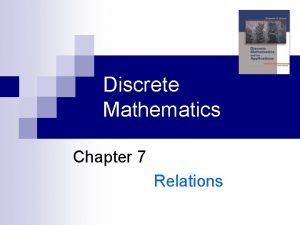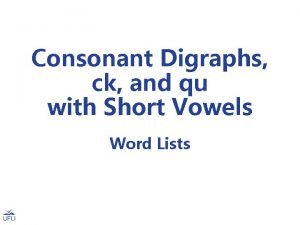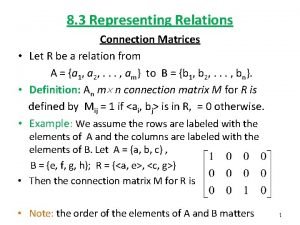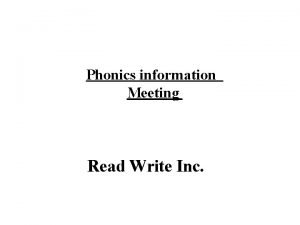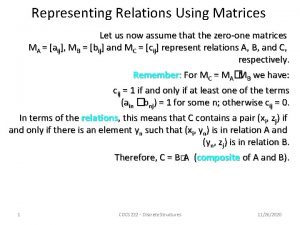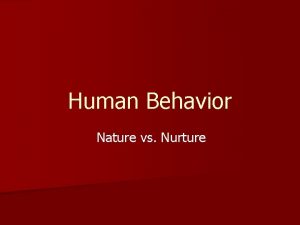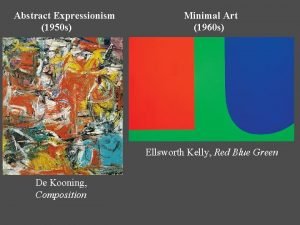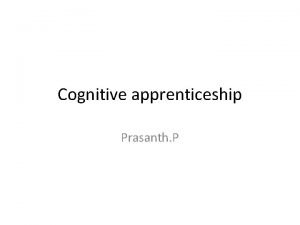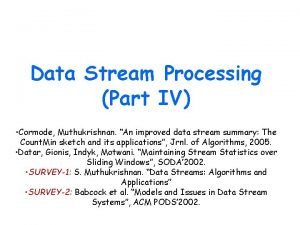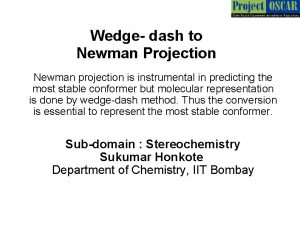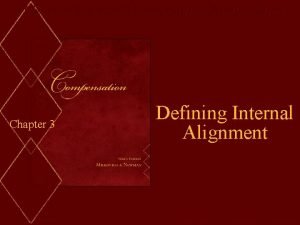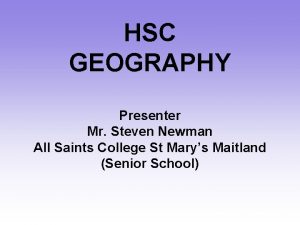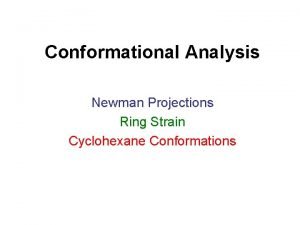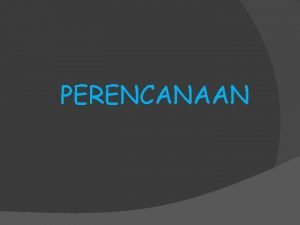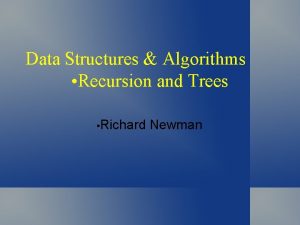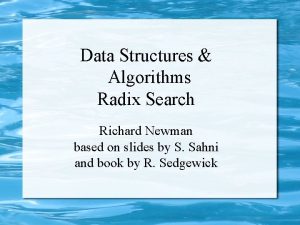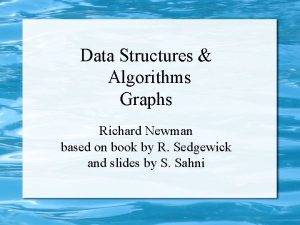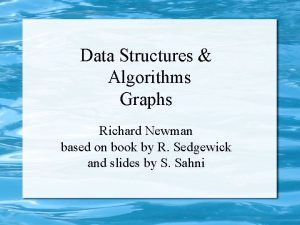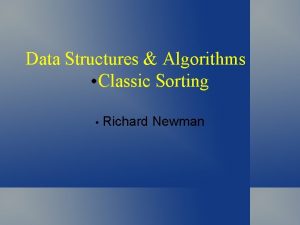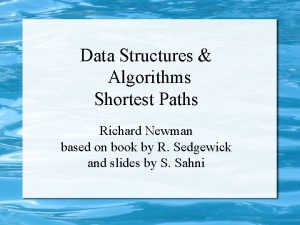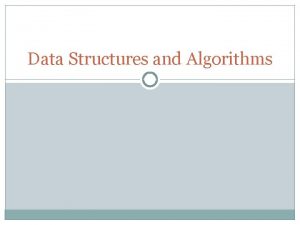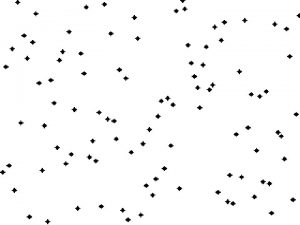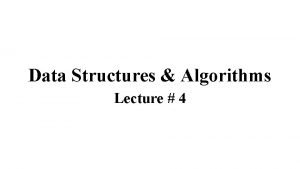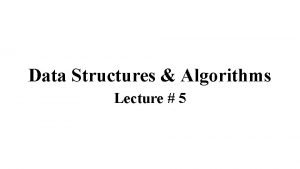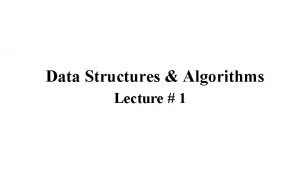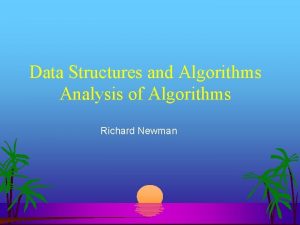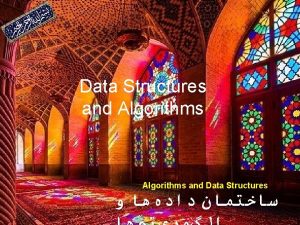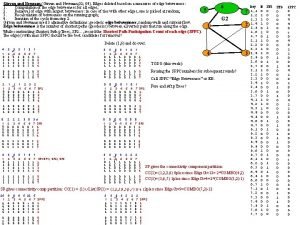Data Structures Algorithms Digraphs and DAGs Richard Newman


























![Transitive Closure • We can improve Warshall’s algorithm by moving the test of A[s][i] Transitive Closure • We can improve Warshall’s algorithm by moving the test of A[s][i]](https://slidetodoc.com/presentation_image_h2/da7bc094791c06a630321451d0fbaf53/image-27.jpg)
![Shortest Path • We can modify Warshall’s algorithm to compute shortest path, if A[][] Shortest Path • We can modify Warshall’s algorithm to compute shortest path, if A[][]](https://slidetodoc.com/presentation_image_h2/da7bc094791c06a630321451d0fbaf53/image-28.jpg)















- Slides: 43

Data Structures & Algorithms Digraphs and DAGs Richard Newman based on book by R. Sedgewick and slides by S. Sahni

Digraphs • Edges are directed • Number of possible undirected graphs is huge • 2 V(V+1)/2 • Number of possible directed graphs is … huger(? ) • 2 V^2

Digraphs V Undir Graphs • Graph enumeration 2 8 Digraphs 16 3 64 512 4 1, 024 65, 536 5 32, 768 33, 554, 432 6 2, 097, 152 68, 719, 476, 736 7 268, 435, 456 562, 949, 953, 421, 312 8 wow Wow wow

Digraphs • Defn. 19. 1: A digraph is a set of nodes V and a set of distinct directed edges E, each from one node to another node in V. (self-loop allowed) • Defn. 19. 2: A directed path in a digraph is a list of nodes for which there is an edge from each node to its successor. A node t is reachable from node s iff there is a d. p. from s to t.

Digraphs • Defn. 19. 3: A directed acyclic graph (DAG) is a digraph with no directed cycles (tours). A node with only outedges is a source; a node with only in -edges is a sink. • Defn. 19. 4: A digraph is strongly connected iff every node is reachable from every node.

DAGs • DAGs can be used to model many real-life problems • Scheduling • Precedence • Pre-requisite structures • Causality • Etc.

Digraphs • Prop. 19. 1: A digraph that is not strongly connected comprises a set of strongly connected components, which are maximal strongly connected subgraphs, and a set of directed edges that go from one component to another.

DAGs • Connected components • 0 -7 -4 -5 -3 2 • 2 -6 1 • 1 6 • 1 0 7 5 4 3

Digraphs • Prop. 19. 2: Given a digraph D, define another digraph K(D) with one node corresponding to each strongly connected component of D, and an edge from u to v iff there is one or more edge from the component corresponding to u to the component corresponding to v. K(D) is a DAG called the kernel DAG of D.

DAGs • DAG Components • 0: 0 -7 -4 -5 -3 • 1: 2 -6 • 2: 1 • Kernel DAG • Component 0 • Component 1 • Component 2 2 0 1 6 1 7 5 4 3 0 2

Digraphs • In undirected graph, we just say two nodes are connected if there is a path between them • In a digraph, node t is reachable from node s if there is a directed path from s to t. • In a digraph, s and t are strongly connected if they are mutually reachable.

Digraphs • Classify edges in DFS • Tree – recursive calls • Back – to ancestor (including parent!) • Down – to visited descendent • Cross – neither ancestor nor descendent (cousins)

DFS in Digraphs 2 0 1 6 7 5 4 3 01234567 pre 0 4 1 7 5 6 2 3 post 7 2 1 3 5 4 0 6 Stack: 0 down 0 572 2 7 576 4 57(2) back 6 1 541 cross 5 54 55(6 cross) 3 53(0 back) 5(4 back) (5 down)

DFS Algorithms • Cycle Detection • If we find a back edge, it represents a cycle – including link to parent! • Cross edges don’t make cycles! • Reachability • Start from one, DFS until find other (or complete DFS) • Weak connectivity • If DFS finds all the nodes, then yes!

DFS Algorithms • Convert digraph to DAG • Remove back edges! • Use to generate large DAGs from large digraphs • Note that DFS in a digraph only gives reachability from the start node, not from all nodes

Transitive Closure • Defn. 19. 5: The transitive closure of a digraph D is a digraph T with the same vertices but with an edge from s to t in T iff t is reachable from s in D. 2 0 1 6 2 7 5 4 3 0 1 6 7 5 4 3

Transitive Closure • Can also view (and compute) transitive closure by Boolean matrix multiplication • Use logical AND as x • Use logical OR as + • Ai represents (any) path of length i A 0 1 2 3 4 5 6 7 0 01 0 0 0 0 0 1 2 1 0 0 0 1 0 3 0 0 0 1 0 0 4 0 0 0 1 5 1 0 0 0 6 0 0 1 0 0 0 7 1 0 0 0 0 A 2 0 1 2 3 4 5 6 7 0 1 0 0 0 1 1 0 0 0 0 2 0 0 1 1 0 0 3 1 0 0 0 4 1 0 0 5 0 0 0 1 0 1 6 1 0 0 1 1 7 0 0 0 1 0 0

Transitive Closure • Can also view (and compute) transitive closure by Boolean matrix multiplication • Use logical AND as x • Use logical OR as + • Ai represents (any) path of length i A<3 0 1 2 3 4 5 6 7 0 01 1 1 0 0 0 0 1 2 1 0 1 1 1 0 3 1 0 0 0 1 1 0 0 4 1 0 0 1 0 1 5 1 0 0 1 1 1 0 1 6 1 0 1 1 7 1 0 0 A 3 0 1 2 3 4 5 6 7 0 0 1 0 1 1 0 0 0 1 2 1 0 0 1 1 3 0 0 0 1 0 1 4 1 0 0 0 1 1 0 1 5 1 0 0 0 1 1 0 0 6 1 0 1 7 1 0 0 0

Transitive Closure • Can also view (and compute) transitive closure by Boolean matrix multiplication • Use logical AND as x • Use logical OR as + • Ai represents (any) path of length i A<4 0 1 2 3 4 5 6 7 0 01 1 1 0 0 1 0 1 1 0 0 1 1 2 1 0 1 1 1 3 1 0 0 1 1 1 0 1 4 1 0 0 1 1 1 0 1 5 1 0 0 1 1 1 0 1 6 1 0 1 1 1 7 1 0 0 0 1 1 0 0 A 4 0 1 2 3 4 5 6 7 0 0 0 1 1 0 0 0 0 1 0 0 0 2 1 0 1 3 0 0 1 1 0 0 4 1 0 0 1 1 1 0 1 5 1 0 0 1 1 1 0 1 6 1 0 0 1 1 1 7 1 0 0 1 0 1

Transitive Closure • Can also view (and compute) transitive closure by Boolean matrix multiplication • Use logical AND as x • Use logical OR as + • Ai represents (any) path of length i A<5 0 1 2 3 4 5 6 7 0 01 1 1 0 0 1 0 1 1 0 0 1 1 2 1 0 1 1 1 3 1 0 0 1 1 1 0 1 4 1 0 0 1 1 1 0 1 5 1 0 0 1 1 1 0 1 6 1 0 1 1 1 7 1 0 0 1 1 1 0 1 A 5 0 1 2 3 4 5 6 7 0 0 1 1 1 0 0 0 1 0 1 2 1 0 0 1 1 1 3 0 0 0 1 1 1 0 1 4 1 0 0 1 1 1 0 1 5 1 0 0 1 1 1 0 1 6 1 0 1 7 1 0 0 0 1 1 0 0

Transitive Closure • Can also view (and compute) transitive closure by Boolean matrix multiplication • Use logical AND as x • Use logical OR as + • Ai represents (any) path of length i A<6 0 1 2 3 4 5 6 7 0 01 1 1 0 0 1 1 2 1 0 1 1 1 3 1 0 0 1 1 1 0 1 4 1 0 0 1 1 1 0 1 5 1 0 0 1 1 1 0 1 6 1 0 1 1 1 7 1 0 0 1 1 1 0 1 • Keep on multiplying and adding until… … reach fixed point Matrix does not change

Transitive Closure • Prop. 19. 5: We can compute the transitive closure of a digraph by adding self-loops, then computing AV, taking time V 4. • Self-loops allow path to be of any length up to exponent • Must reach fixed point by V – why? • Efficient approach: • A, A 2, A 4, A 8, … successive squaring • Takes lg V matrix multiplies, each V 3 • Total time is V 3 lg V

Transitive Closure • Even faster way! • Warshall’s algorithm: for (i = 0; i < V; ++i) for (s = 0; s < V; ++s) for (t = 0; t < V; ++t) if (A[s][i] && A[i][t]) A[s][t] = 1;

Transitive Closure Correctness by induction on i: Base: After first iteration, s-t or s-0 -t After second iteration, s-t, s-0 -t, s-1 -t, s-0 -1 -t, s-1 -0 -t. IH: After ith iteration – all paths w/o inner nodes > i Inductive step: path from s to t w/o i+1 (already there) or path via i+1 (tested by if statement) for (every intermediate node i) for (every source s) for (every destination t) if (s reaches i & i reaches t) s reaches t;

Transitive Closure • Prop. 19. 7: Warshall’s algorithm computes the transitive closure of a digraph in time V 3. • Obvious from structure of Warshall’s algorithm – three nested loops of V each: for (i = 0; i < V; ++i) for (s = 0; s < V; ++s) for (t = 0; t < V; ++t) if (A[s][i] && A[i][t]) A[s][t] = 1;

Transitive Closure • Prop. 19. 8: We can support constant-time reachability testing for a digraph with V nodes using space O(V 2) and preprocessing time O(V 3). • Can improve Warshall’s algorithm: for (i = 0; i < V; ++i) for (s = 0; s < V; ++s) for (t = 0; t < V; ++t) if (A[s][i] && A[i][t]) A[s][t] = 1;
![Transitive Closure We can improve Warshalls algorithm by moving the test of Asi Transitive Closure • We can improve Warshall’s algorithm by moving the test of A[s][i]](https://slidetodoc.com/presentation_image_h2/da7bc094791c06a630321451d0fbaf53/image-27.jpg)
Transitive Closure • We can improve Warshall’s algorithm by moving the test of A[s][i] out of the inner loop, avoiding innermost loop when s cannot reach i. for (i = 0; i < V; ++i) for (s = 0; s < V; ++s) if (A[s][i]) for (t = 0; t < V; ++t) if (A[i][t]) A[s][t] = 1;
![Shortest Path We can modify Warshalls algorithm to compute shortest path if A Shortest Path • We can modify Warshall’s algorithm to compute shortest path, if A[][]](https://slidetodoc.com/presentation_image_h2/da7bc094791c06a630321451d0fbaf53/image-28.jpg)
Shortest Path • We can modify Warshall’s algorithm to compute shortest path, if A[][] contains the length of the minimum path from s to t (initialized with 1 for an edge and sentinel value V for no edge). for (i = 0; i < V; ++i) for (s = 0; s < V; ++s) for (t = 0; t < V; ++t) if (A[s][i] + A[i][t] < A[s][t]) A[s][t] = A[s][i] + A[i][t];

Reduction • Prop. 19. 9: We can use any transitiveclosure algorithm to compute the product of two Boolean matrices with at most a constant factor difference in running time. • Prf: Construct a 3 v x 3 v matrix using A, B, and Vx. V identity matrix I. TC is square. 2 I A 0 I A AB 0 I B 0 0 I = 0 0 I 0 B I

Reduction • What this means is that if we can perform transitive closure faster, then we can compute Boolean matrix products faster. • Likewise, a faster Boolean matrix multiply algorithm will speed up our TC algorithm. • Note that we can compute TC faster for sparse graphs – time O(V(E+V))

Topological Sort • Relabel: Given a DAG, relabel its nodes such that every directed edge points from a lower-numbered node to a highernumbered node. • Rearrange: Given a DAG, rearrange its nodes on a horizontal line such that all the directed edges point from left to right. • Key = turn partial order into total order that is consistent with the partial order

Topological Sort 2 Relabel: 0 1 7 6 2 7 5 4 1 2 3 6 Rearrange: 3 0 0 7 1 4 5 7 1 5 4 3 6 2

Reverse Topological Sort • Relabel: Given a DAG, relabel its nodes such that every directed edge points from a higher-numbered node to a lowernumbered node. • Rearrange: Given a DAG, rearrange its nodes on a horizontal line such that all the directed edges point from right to left. • Just reverse the regular topological sort

Topological Sort • Prop. 19. 11: Postorder numbering in DFS yields a reverse topological sort for any DAG. • It is easy to turn reverse topological sort into a regular topological sort

Topological Sort • Prop. 19. 12: Every DAG has at least one source and at least one sink. • Turn this into a topological sort algorithm: 1. Make indegree[V] vector initialized to 0 2. Scan through DAG (visiting every edge) and increment indegree[i] each time an edge to node i is found. 3. Scan through indegree[] and enqueue all nodes with indegree zero (the sources).

Topological Sort • Prop. 19. 12: Every DAG has at least one source and at least one sink. 4. Set current. ID = 0. 5. While the queue is non-empty, 6. remove a node x and label it current. ID 7. current. ID++ 8. Decrement indegree[j] for all edges from node x to node j 9. If indegree[j] == 0, enqueue node j

Topological Sort 2 0 1 6 2 7 7 5 4 3 0 1 3 6 7 2 5 4 1 3 indegree: 0 01 012 0 012 1023 10 01 Source Queue: 0 3 7 1 4 5 6 2

Topological Sort Application • Finding longest path from each node, longest path in DAG • “Critical path” for scheduling • What is the most urgent thing to do? • Reverse topological sort DAG • In RTS order, for each node v, longest path from v, LP[v] = 1 + max{LP[x] | (v, x) in E} • Guaranteed that LP[x] is known by time it is needed. Example of… Dynamic Programming!

Topological Sort 2 7 0 1 3 6 7 2 5 4 1 3 Longest path: 5 4 4 1 3 1 2 1

Transitive Closure Redux Reachability from each node in DAG • Reverse topological sort DAG • Row vector Reach[v] – initially self and successors • In RTS order, for each node v • Reach[v] = OR {Reach[x] | (v, x) in E} • Guaranteed that Reach[x] is known by time it is needed. Another example of… Dynamic Programming!

Transitive Closure Redux • Matrix approach takes time O(VE) • Direct recursive DFS approach: • No back edges (no cycles) • Tree edges – recursive call • Cross edges – do OR, no call • Down edges – skip, no call • Prop. 19. 13: Using DFS and DP, can compute TC of a DAG in time O(V 2+VX) where X is the number of cross edges

Strongly Connected Components • Kosaraju’s method • Do DFS on reversed digraph • Compute post-order numbering • Do DFS of original graph using reverse of postorder computed on reverse graph • Time and space are both linear in V+E!

Recap • • • Digraphs Strong connectivity Connected components Reachability Digraph kernel Transitive closure Shortest paths (special case) Reduction (from Boolean matrix multiply) Topological Sort
 Professor ajit diwan
Professor ajit diwan Cos 423
Cos 423 Data structures and algorithms tutorial
Data structures and algorithms tutorial Information retrieval data structures and algorithms
Information retrieval data structures and algorithms Data structures and algorithms bits pilani
Data structures and algorithms bits pilani Ajit diwan
Ajit diwan Data structures and algorithms
Data structures and algorithms Data structures and algorithms
Data structures and algorithms Waterloo data structures and algorithms
Waterloo data structures and algorithms Information retrieval data structures and algorithms
Information retrieval data structures and algorithms Data structures and algorithms
Data structures and algorithms Dags chen
Dags chen Algorithms + data structures = programs
Algorithms + data structures = programs Richard newman uf
Richard newman uf Antisymmetric relation
Antisymmetric relation Consonant digraphs ck
Consonant digraphs ck Symmetric relation
Symmetric relation Representing relations using digraphs
Representing relations using digraphs Fips country code
Fips country code Rwi split digraphs
Rwi split digraphs Representing relations using matrices
Representing relations using matrices Rwi split digraphs
Rwi split digraphs King richard iii and looking for richard
King richard iii and looking for richard Homologous structures
Homologous structures Gerald levey and mark newman
Gerald levey and mark newman Gerald levey and mark newman
Gerald levey and mark newman Gerald levey and mark newman
Gerald levey and mark newman Joseph kosuth: one and three chair barnett newman
Joseph kosuth: one and three chair barnett newman Cognitive apprenticeship collins brown and newman
Cognitive apprenticeship collins brown and newman Gerald levey and mark newman
Gerald levey and mark newman Stream data model
Stream data model Cis decalin newman projection
Cis decalin newman projection Universidad san pedro chimbote
Universidad san pedro chimbote Newman projections practice
Newman projections practice Milkovich newman compensation, 9th edition pdf
Milkovich newman compensation, 9th edition pdf Margaret newman theory application
Margaret newman theory application Francis drake accommodation plymouth
Francis drake accommodation plymouth Ecosystems at risk hsc notes
Ecosystems at risk hsc notes Cyclobutane newman projection
Cyclobutane newman projection Cardinal newman cedar
Cardinal newman cedar Batasan perencanaan
Batasan perencanaan Newman projection generator
Newman projection generator Barnett newman abraham
Barnett newman abraham Robert c newman ii
Robert c newman ii














